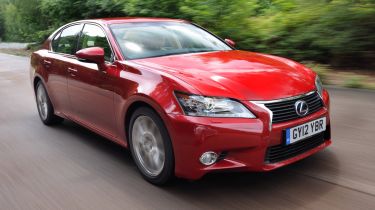Lexus GS 450h
So does petrol-electric power give latest executive car an edge over class leaders?
The original GS 450h was the world’s first rear-wheel-drive hybrid sports saloon, but its styling didn’t reflect the cutting-edge technology lurking under the bodywork. And unfortunately, the latest model does little to change that.
It’s a conservative-looking executive saloon which blends into the background rather than announcing its arrival. This isn’t unusual for Lexus, and some customers no doubt like the company’s low-key approach; it’s just a pity the GS already looks so dated.
It’s a similar story once you step inside the cabin. There’s no faulting the quality of the leather, inlays and trim, and – as you would expect in a Lexus – everything is faultlessly put together. Yet the design appears a bit too old-fashioned.
The upper section of the dashboard is focused around the 12.3-inch colour screen, but the way the plastics blend down into the display isn’t as neat a solution as the A6’s automatically retracting flat-screen. And while Lexus’ computer mouse-inspired Remote Touch Interface controller has been improved, it’s still over-sensitive and not as easy to use as the Audi and BMW systems.
There are other niggles, too. The electric park brake button is hidden away below the steering wheel, while the temperature read-out for the air-conditioning looks like it’s from an eighties’ digital watch. And although the steering column’s telescopic reach has been increased by 50mm, the Lexus still doesn’t have as wide a range of steering and seat adjustment as its rivals here.
Used - available now

2023 Kia
Sportage
31,275 milesAutomaticPetrol1.6L
Cash £26,400
2022 Mercedes
GLA
14,327 milesAutomaticPetrol1.3L
Cash £27,300
2023 Honda
Jazz
14,597 milesAutomaticPetrol1.5L
Cash £16,000
2023 Land Rover
Discovery Sport
34,981 milesAutomaticPetrol1.5L
Cash £27,700The seats themselves are impressively comfortable, plus come heated and cooled as standard. In the back, passenger space is adequate, but with no increase in wheelbase over the outgoing model, there’s a fraction less legroom than in the Audi or BMW.
The biggest improvement over the old car is a 55 per cent increase in boot space, which comes as a result of better battery packaging, although the 465-litre capacity is still 55 litres smaller than the BMW’s.
Still, the nickel-metal hydride batteries, electric motor and 286bhp 3.5-litre V6 petrol engine combine to deliver a maximum output of 341bhp – meaning that the GS has the performance to match the large-capacity diesels in this test.
Despite weighing in at a hefty 1,930kg, the Lexus accelerates from 0-60mph in 5.9 seconds – a mere four tenths behind the BMW. On paper, in-gear response trails the diesels slightly, but in reality none of the cars in this test is short on acceleration when you press the throttle.
The V6 engine itself is unobtrusive to the point of being bland, while under hard acceleration the CVT transmission keeps the revs high for long periods, contrasting with the effortless torquey refinement of the BMW and Audi. Around town you get the benefit of silent zero-emissions driving, but anything other than very light throttle inputs will see the petrol engine cut back in. Pick up speed and refinement continues to be a strong point, yet despite a soft set-up the suspension fails to iron out imperfections, and the ride is unsettled over poor surfaces.
The GS also struggles to control roll in corners. There’s more body movement than in its rivals, while the light steering lacks feel. Worse still, the regenerative braking set-up results in an uneven and grabby pedal response.
On the plus side, improved hybrid technology means the GS 450h is 20 per cent more fuel efficient than the outgoing model and produces only 141g/km of CO2 – so it’s the cleanest in our test on paper.
Add in the lowest list price and it’s also the cheapest company car, although if you opt for the racy £50,995 F Sport model, the Benefit in Kind tax bill rises steeply. Regardless of spec, you’re likely to suffer average fuel returns and heavy depreciation – we managed only 30.8mpg and our experts predict 30.9 per cent residuals.
So bearing in mind the GS 450h’s dynamic compromises, it’s clear that Lexus has a tough job on its hands to steal sales from established diesel executive models.
Details
Chart position: 3Why? The GS has always been an alternative choice to the upmarket European saloons that dominate this sector. Can all-new model finally shake up the class order?







